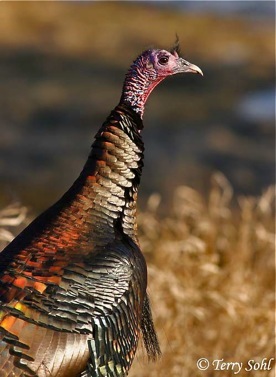Phylogeny

Classification of
the wild turkey
“Meleagris gallopavo”
Eukarya

Animalia

Chordata

Aves

Galliformes







Megapodiidae
Cracidae
Tetraonidae
Phasianidae
Meleagrididae


Opisthocomidae

See Below!


* = Extinct



Parapavo*
Meleagris
Agriocharis
What the Latin Scientific name means in English:
When the Europeans first came to the new world they confused the turkey with the guinea fowl, which was native to Europe. Therefore, it was called Meleagris which is actually Greek. Likewise, Gallopavo is synonymous for the word turkey which shows more confusion with the guinea fowl. Meleagris means Guinea fowl and Gallus means cock. Pavo means peafowl.
So... I know that the wild turkey’s scientific name is Meleagris gallopavo, but why?
The turkey is broken down through eight taxonomic levels: Domain, Kingdom, Phylum, Class, Order, Family, Genus, Species. Each level has specific criteria for that animal to fall under. The following will briefly explain each levels criteria!
The turkey is in the level...
-
-Eukarya because all members possess a nucleus as well as membrane bound organelles.
-
-Animalia because all members do not have a cell wall, but are motile at some stage, heterotrophic (other feeding), and multicellular.
-
-Chordata because all members have a notochord (skeletal rod), pharyngeal pouches at some stage, endostyle (thyroid gland), and post-anal tail.
-
-Aves because all members have wings, air cavities in skeleton, amniotic eggs, beak with no teeth, and eggs are fertilized internally.
-
-Galliforms because all members are small to large, fowl-like birds, that have short, stout bills, short, rounded wings, and short legs. (5)
-
-Meleagrididae because all members are very large gamebirds that are dark, with a green and bronze sheen, and have a bare, blue or red head with wattles. (5)
-
-Meleagris because all members are have characteristic bare, red head wattles, and a ‘gobbling’ call.
-
-Meleagris gallopavo because they are found in North America and are bigger than Agriocharis ocellata
The Wild Turkey was placed into these particular phyla based on morphological characteristics. For example, they were placed in the Meleagrididae because they are large gamebirds that are dark and have a green and bronze sheen with a bare or red head.
Turkeys are also closely related to Pheasants.

Meleagris gallopavo
Agriocharis ocellata


Photo by Terry L. Sohl


Quick Fact!
the name meleagris arose from mythology! Meleager was the son of Oeneus, king of Calydon. When meleager died his sisters mourned for him and while doing so were transformed into birds, or meleagrides!!
If you would like to know other interesting facts...

